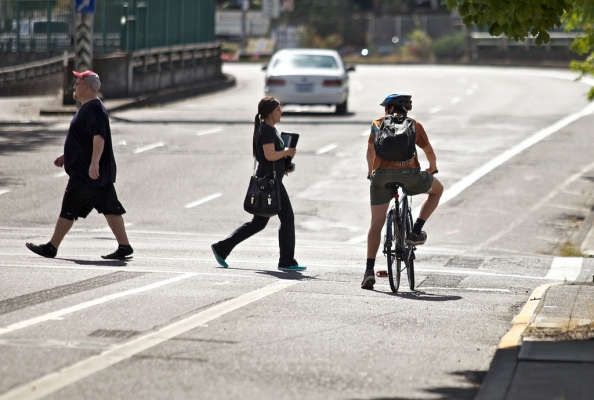
View slides
Watch video:
For a number of reasons—congestion, public health, greenhouse gas emissions, energy use, demographic shifts, and community livability to name a few—the importance of walking and bicycling as transportation options will only continue to increase. Currently, policy interest and infrastructure funding for nonmotorized modes far outstrip our ability to successfully model bike and walk travel. In the past five years, we have learned a lot about where people prefer to bike and walk, but what can that tell us about whether people will bike or walk in the first place? The research presented here is designed to start bridging the gap between choice of route and choice of travel mode (walk, bike, transit, drive, etc.).
A mode choice framework is presented that acknowledges the importance of attributes along specific walk and bike routes that travelers are likely to consider for a given trip. Adding route quality as a factor in mode choice decisions is new, and shows promise for: (1) improving prediction of pedestrian and cycling trips, (2) increasing sensitivity of models to finer-grained policy scenarios--testing the impact of a single proposed facility or design change on bike and walk mode shares, and (3) identifying separately the effects of pedestrian and cycling facilities on decisions to walk or ride from which route to take.
The proposed framework is applied to revealed preference, GPS travel data collected from 2010-2013 in Portland, Oregon. Key results include: (1) specific walk and bike facilities are significant factors for mode as well as route choice, (2) lower traffic-stress routes may be more important for women than men when choosing whether to bike, (3) available routes on a specific trip may have independent impacts from more traditional measures of land-use and built environment such as density, and (4) the importance of walking and biking environments appears to remain even when controlling for neighborhood self-selection.
Joseph Broach is a Research Associate with the Transportation Research and Education Center (TREC) and an Instructor in the School of Urban Studies and Planning at Portland State University. He holds a master's degree in economics from the University of Montana and a doctorate in urban studies from Portland State. His work primarily focuses on transportation data, behavior, and modeling, and he helped design the Portland region's next-generation bicycle model in conjunction with Metro. In his free time he enjoys cycling, fly-fishing, and exploring great urban places.